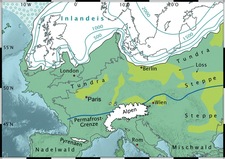Geologic long-range prognosis
Conclusions can be drawn to events possibly occurring in the future from geological events having occurred in the past . For the safety of the Konrad repository geological events have been investigated that could influence the Konrad site, should they occur in future.

![]() Example showing glacial distribution in northern Europe during the Saale Ice Age
Example showing glacial distribution in northern Europe during the Saale Ice Age
In the course of geological history several ice ages occurred, each of them lasting up to some million years. Currently we live in an interglacial period, the Holocene, which began approximately 10,000 years ago and whose temperature peak was exceeded about 4,500 years ago. From the climatic viewpoint, a new ice age could thus begin in some thousand to ten thousand years.
Insignificant change of the rock barrier due to ice and frost
The profound freezing of the soil during an ice age influences the hydrogeological conditions. During this period precipitation is lower because the major part of the water in the water cycle is already bound in the form of snow and ice. In addition, the ground is frozen so solidly that water can only penetrate it with difficulty. Thus, less groundwater is generated, which only moves slightly. In Northern Germany, the salt content of the groundwater increases from a depth of about 130 to 170 metres and lowers the temperature at which it freezes. Conclusion: The hydrogeological and rock-mechanic features of the barrier rocks would only slightly change during a new ice age.
Repository not at risk through removal of soil

![]() Simplified West–East cross section in the region of the Konrad mine, Shaft 2
Simplified West–East cross section in the region of the Konrad mine, Shaft 2
When the ice moves, underground areas are at first removed up to some ten metres, forming ground and end moraines consisting of the removed material (debris). Locally, deeper cavities form through the ice itself or its interaction with melt waters. In the vicinity of the Konrad mine, however, no quaternary subsidence above 100 metres below the earth's surface have been detected. Due to its deep location, the iron ore deposit in which the repository will be established, and due to the dispersion, thickness and the physical and chemical behaviour of the barrier rocks, it can be ruled out that the repository will be at risk.
Impact of a global warming
The forming powers are relatively low in interglacial periods. A warming and changes in climatic zones because of anthropogenic influences (warming) mainly affect the hydrological conditions. Due to a dryer climate or, respectively, higher evaporation rates, less new groundwater generates, the groundwater movements slow down. Higher annual temperatures world-wide release the bodies of water that are still bound as inland ice today and increase the sea level by up to 75 metres. Thus, no vital changes will occur for the aquifers near the surface; however, lower flow velocities are expected for the deeper-lying groundwater storeys on account of changed pressure ratios.
State of 2016.04.01

